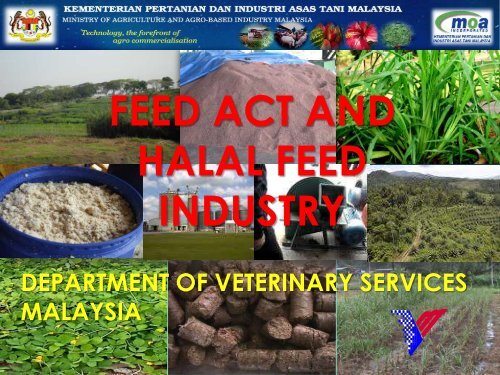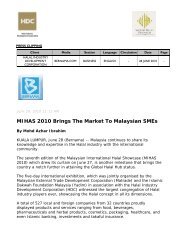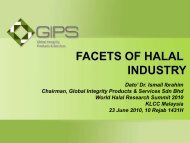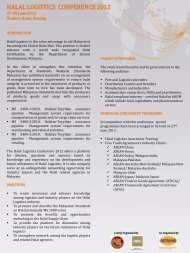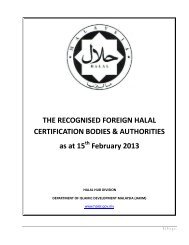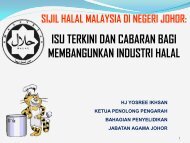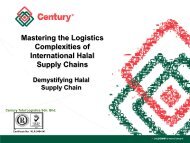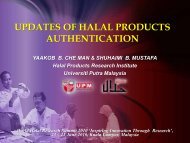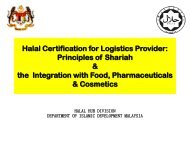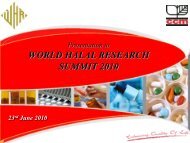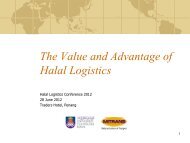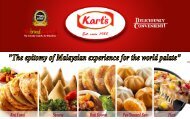FEED ACT AND HALAL FEED INDUSTRY - hdc
FEED ACT AND HALAL FEED INDUSTRY - hdc
FEED ACT AND HALAL FEED INDUSTRY - hdc
Create successful ePaper yourself
Turn your PDF publications into a flip-book with our unique Google optimized e-Paper software.
<strong>FEED</strong> <strong>ACT</strong> <strong>AND</strong><strong>HALAL</strong> <strong>FEED</strong><strong>INDUSTRY</strong>DEPARTMENT OF VETERINARY SERVICESMALAYSIA
ANIMAL <strong>FEED</strong> REQUIREMENT• Feed constitute 60-70% of total cost of livestockproduction.• Annual requirement of animal feed approx. 7 milliontones.• Major users of feed are intensive livestock industries(poultry & swine)• Ruminant industry, extensive and semi-intensivesystem depend mainly on pasture and locally availablefeedstuff.
ANIMAL <strong>FEED</strong> <strong>INDUSTRY</strong>• Feed milling industry produces 5 mil. tonnes ofcompounded feeds annually• 53 compounded feed manufacturing feed mills• Home mixers mainly the swine sector• Feed manufacturers – 4.9 million metric tons• Home mixers – 350,000 metric tons
..ANIMAL <strong>FEED</strong> <strong>INDUSTRY</strong>• Imported ingredients : 70-80%• Mainly maize and soya bean meal• Local ingredients : 20-30%• Mainly PKC and agro-industrial products• Chicken and swine highly dependant on imported feedingredients• Open to international market forces• Ruminant highly dependant on local feed stuffs• Open to local production forces
..ANIMAL <strong>FEED</strong> <strong>INDUSTRY</strong>Quantity(tonne)2007 2008RM ( ‘000)Quantity(tonne)RM ( ‘000)IMPORT 3,886,218 3,765,743 3,531,990 4,426,935EXPORT 2,256,824 1,000,898 2,199,686 1,211,348
Safe Feed for Safe Food• Controlling quality of feed becomes importantbecause feed cause direct impact to food that originatefrom animal product• Feeds and feed additives an important link in animalproduction chain; directly influence quality and safetyof animal food products• Need for governmental intervention in assurance offeed quality & safety
Animal Feed Violation• Animal feeds isrecognized as a potentialsource of residueshazards• Chemicals will remainsin the feed or feedingredients regardless ofthe production process
Feed Additives• Antibiotics/drugs: disease prevention/medications• Coccidiostats: control parasites• Xanthophyll: makes egg yolks yellow• Hormones: increases growth• Tranquilizers: calms nerves (cattle, turkeys)• Antioxidants: prevents feed from getting rancid• Pellet Binders: keeps feed in pellet form• Flavoring Agents: makes feed taste better
Growth Hormones• Natural hormone• estradiol or estrogen, progesterone, and testosterone• Synthetic hormone• zeranol, melengestrol acetate, and trenbolone acetate• Artificial Hormone• Recombinant bovine somatotropin (rBST)• Effect of growth hormone (eg. rBST)• Caused mastitis in cattle• Linked to colon and breast cancer in human
Types of Residues• Medication or feedadditives permitted foruse in animal feed but atlevel exceeding MRL orcross-transferred to thewrong target feed type orspecies• Banned antibiotics(Chloramphenicol,Nitrofuran)
Effect of supplement as feed additive• Growth hormone (eg. rBST)• Caused mastitis in cattle• Linked to colon and breast cancer in human• Increased use of ruminant bone and meat meal forcattle appear to have played a role in the emergence ofBSE• Adding low levels of antibiotics to animal feed in orderto increase growth rate has raised concern about thetransfer of antibiotic resistance to human pathogensfrom this practice (VRE)
DVS Feed Laboratory• Veterinary Public Health/Regional Veterinary Laboratories• Veterinary Research Institute• National Animal Feed Reference LaboratoryType of analysis Equipment Methods RegulationMycotoxin HPLC-Fluorescent 1. AOAC Method2. VICAM Manual(Supplier Method)3. SIRIM StandardNitrofuran HPLC-PDA 1. SIRIM Standard2. International JournalChloramphenicol LC-MS 1. In house method2. International Journal3. Supplier methodBeta Agonist LC-MS 1. In house method2. International Journal3. Supplier method1. EU Regulation2. USA Regulation1. EU Regulation1. EU Regulation1. EU Regulation
YEAR2007 2008 2009TESTTotalsamplesNumberpositiveTotalsamplesNumberpositiveTotalsamplesNumberpositiveBeta agonist(Salb. Clen, Terb, Racto)673 1 48 0 79 0Nitrofuran (NFZ, FZD, FTD)24 0 42 0 36 0Chloramphenicol23 0 39 0 34 0Mycotoxin- Aflatoxin (B1, B2, G1, G2, M1)15520ppb= 125520ppb=1614820ppb= 8Source : Veterinary Public Health Laboratory, Department of Veterinary Services, Malaysia
THE <strong>FEED</strong> <strong>ACT</strong> 2009• Gazetted on 3 rd September 2009.• Date of operation on 1 st January 2010• Purpose• to regulate feed quality by controlling the importation,manufacture, sale and use of feed and feed additive• to ensure that feed satisfies nutritional requirement ofanimals, is not harmful to animals and is notcontaminated so that animals and animal products aresafe for human consumption and other usage• For other matters incidental thereto
Provision• Animal Feed Board (14 member)• Licensing• Specification and conditions• Keeping, storing, packaging, labelling and transporting• Control use of antibiotics, hormones and otherchemicals• Designation of laboratories, appointment andcertificate of analysis
Rules & RegulationsRegulations may be made for the following purpose. (Clause 53 (2)).1) to prescribe the analyst’s qualifications, conduct and duties;2) to prescribe all matters relating to application, renewal, suspension andrevocation of license to import feed or feed additive;3) to prescribe the terms, conditions and restrictions of license to importfeed or feed additive;4) to prescribe all matters relating to feed specifications and standards andmake provisions for giving effect to such specifications and standards;5) to prescribe all matters relating to the transporting, storing, keeping,labelling and packaging of feed or feed additive;
..Rules & Regulations6) to prescribe all matters relating to the use of feed additive, antibiotics,hormones or other chemicals;7) to regulate the manufacture, sale, advertisement and use of feed or feedadditive;8) to prescribe the method of analysis of feed and the form of certificate ofanalysis;9) to designate laboratories and provide for its functions; and10)to prescribe the fees payable under this Act;11)to prescribe the offences which may be compounded;12)to provide for such other matters as are contemplated by, or necessary forgiving full effect to, the provisions of this Act and for their dueadministration.
..Penalty• First Offence:• RM100,000.00 and 2 yrs jail (NE) or both• Second Offence:• RM200,000.00 and 4 yrs jail (NE) or both
THE NEW <strong>FEED</strong> INITIATIVES
The New Feed Initiatives• Intensive fodder production• Hydroponic• Semi Enclosed Green House• Insect/pest proof• Hybrid variety• Legumes• Grasses• Grains (legumes and cereals)• Collabn: Seed company – Pioneer, Heritage, Pacific
The New Feed Initiatives• Integrated agriculture• LPP, DOA, IADAs, KADA, MADA• Coconut/Corn/Legumes• Oil Palm/Legumes/Grasses• Example• Grass + Legumes = Energy + Protein• Hay• Silage• Grass/Legume Cubes
The New Feed Initiatives• Agro-industrial waste• Palm Kernel Product• New technology of kernel processing• Pineapple• Rice• Total Mix Ration• Green• Grain• Mineral• EM
Exploiting local feed resources• Improving the nutritive value of Palm kernel cakeby better oil extraction method• No shell/impurities and/or ‘burnt’• Prioritizing the local use of PKC in non-ruminantanimals• MPOB Q PKC – can replace corn up to 800,000 tons• We use only 5% PKC locally• Provide incentives for higher local consumptioninstead of export
..Exploiting local feed resources• Encouraging theplanting of starch crops(tapioca, sweet potatoand sago) as alternativefeed resources in place ofcornPlantsTapiocaSweet potatoSagoPercent substitution rateon corn (poultry feed)3050-10030
..Exploiting local feed resources• Encouraging silageproduction as a businesssuch as corn stover,pineapple plants,grasses, etc for ruminantanimalsFeedOil palm frondsRice strawCorn stoverPineapple wastePineapple plantsProduction capacity(metric ton)26.2 million650,000192,00044,5003.45 million
Improving nutrient utilization offeed ingredients• Fiber degradation technology• Most byproducts are high in fibre. Fibre is high inenergy but not readily available• Use of biologicals• Enzymes – mannase, beta glucanase• Effective and indigenous microorganisms (EM/IM)• probiotics
Maximize arable land usage• We are facing less available land for agriculture• Idle land can be utilized by planting grasses for fodderproduction.• Fodder production can be a business venture to largeintensive farmers.
Areas of Cooperation Between D-8 countries• Exchange of information• Promotion of joint investment and trade• Cooperation in Research and Development• Human resource development and capacity building• Intensify private sector participation and public-privatesector collaboration in D-8 animal feed cooperation,programmes, projects and activities• Promote environmentally and socially responsible resourcemanagement and development
Halal Animal Feed• In providing halal animal feed is to ensure thatlivestock were not treated with non-halal growthhormon• Animals fed with plant based feed or organic feedconsist of no non-halal animal derived ingredients• Halal status does not refer only to the products but it ismore critical during the process and manner in whichproducts are handle
..Halal Animal Feed• The Feed Act can incorporate Halal requirement in theRegulations• Voluntary basis in getting JAKIM Halal certification• Eg. Nuinfra Mutiara Feedmills Sdn Bhd (Terengganu)• To apply syariah principles in production andtrade• Malaysia Halal Feed Standard
..Halal Animal Feed IndustryGrassGrainMineralsPre-mixBiologicals
MalaysianHalalStandard
Department of Veterinary Services Malaysia


